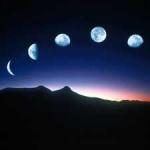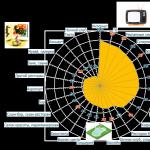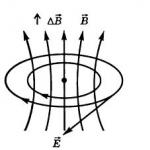Few people already know that in 1929 the following dates were still considered non-working days:
Almost all holidays were canceled and became simple working days. Not only religious holidays, but even the New Year were no longer celebrated. However, a few years later, Christmas was replaced by the New Year. At the same time, a new character appeared - Santa Claus.



If you miraculously preserved calendars for 2002, 1991, 1985, then you can use them in 2019.
In general, calendars almost completely coincide with each other by year exactly after 6, 11 or 28 years.
Years are divided into leap years and three non-leap years: pre-leap, post-leap and regular.
The calendar can completely coincide only in a cycle divisible by 4 (recurrence of leap years) + 7 (recurrence of the day of the week) + 12 - (recurrence of cycles according to the zodiac).
The fact that the historical development of humanity occurs in a certain cyclicity is evidenced by the phenomenon of similarity in the historical development of civilizations separated by eras and spatial distances, which was established by I. Newton, L. Gamon, F. Gregorovius, A. Fomenko, V. Kalashnikov, N. Kellin, S. Rachev, V. Fedorov, L. Morozova, G. Nosovsky.
For example, the identity of the dynasties of the Roman Empire of the 3rd - 6th centuries AD was discovered. and the medieval Empire of Charlemagne VII - VI centuries AD, separated by 360 years. It turned out that the change of rulers in both dynasties, their number and time of reign completely coincide. The course of historical events repeats itself.
A similar cycle of repetition of historical events was discovered between the Roman empires during the reign of Caesar and Diocletian (333 years); between the ancient Tarquinian War in Rome and the medieval Gothic War in Rome (1053 years). Scientists also note the “parallelism” between Roman history of the 1st - 6th centuries AD. e. and the Holy Roman Empire of the 10th - 13th centuries; between English history and Byzantine-Roman history; between Chinese and European history; between ancient Egyptian and European history, etc.
Research conducted by A.T. Fomenko made it possible to identify periods of revival of dynasties (repetition of historical events), which amounted to approximately 330, 1050 and 1780 years. And although some researchers associate such a “chronological shift” with the falsification of history, however, this conclusion turns out to be extremely incorrect (not with regard to the falsification of history). Using the method of analogy, we can ask the following question: “How then can highly respected scientific minds explain the similarity of the fates of Hitler and Napoleon, as well as American presidents A. Lincoln and J. Kennedy?”
The fact is that in the historical dates of Napoleon and Hitler there is a cyclicity of 129 years, and that of the American presidents Lincoln and Kennedy - in 100 years. With an interval of 539 years, the events of the lives of St. Louis and King Louis are repeated XVI .
So, Napoleon was born in 1760, and Hitler in 1889. Napoleon came to power in 1804, and Hitler in 1933. Napoleon entered Vienna in 1809, and Hitler in 1938. Napoleon attacked Russia in 1812, and Hitler in 1941. Both suffered the collapse of their endeavors because of Russia, one in 1816, the other in 1945. Both came to power at 44, attacked Russia at 52, and lost the war when they were 55. The death of both is a mystery to many researchers.
Now about American presidents. Lincoln became president of the United States in 1860, and Kennedy in 1960. Both presidents tragically died in the presence of their wives, and both murders occurred on Friday. Both were succeeded by presidents named Johnson. Both Johnsons were Democratic senators from the southern United States and their birth dates were 1808 and 1908, respectively. Lincoln's assassin, Wido, was born in 1829, and Kennedy's assassin, Oswald, in 1929. Wido committed the crime in a theater and then hid in a warehouse .Oswald fired from a warehouse and then tried to escape into a movie theater. Both presidents were killed by bullets that entered the head from behind. Lincoln was killed at Ford's Theater, and Kennedy was killed while riding in a Lincoln car manufactured at Ford plants. Each of Presidential wives had previously lost one son each, already at a time when the families lived in the White House.
Lincoln's secretary had the last name Kennedy, and Kennedy's secretary had the last name Lincoln. Both secretaries gave the presidents advice on the day of the murder not to leave the residence, and both presidents fatally did not listen to the voice of fate. However, in addition to fatalism (and this is stated in all esoteric sources), free will always exists. Astrology is also based on this principle, which allows the intervention of free will in what is destined by “fate” or world cycles of history.
At the end of the year, old calendars can not be thrown away, but reused for their intended purpose. There is a certain pattern in the coincidence of calendars of different years exactly down to the days of the week and numbers. This way you can save a little. How often does the calendar repeat?
Leap year calendars coincide completely after 28 years. That is, the calendar of the past 2016 turned out to be identical to the one that people used in 1988, and will also be relevant for 2044.
The arithmetic for other years is a little more complicated. To find out which old calendar should be used in 2017, that is, in the post-leap year, we need to subtract 11 from this number. That is, for 2017, the calendar of 2006 or 1995 would be useful to us. To calculate the next time we need the 2017 calendar, we need to add 6. That is, the current year’s calendar needs to be stored until 2023.
In the pre-leap year we do the opposite. For 2015, calendars from 2009, 2003 or 1997 would be useful. But the 2015 calendar will only be needed in 2026.
There is one more year between the post-leap and pre-leap years (in the Julian calendar, every fourth year is a leap year, and in the Gregorian calendar, by which time is calculated in most countries of the world, there are exceptions to this rule). Let's call him regular. In our case, this is the year 2014. The calendars of 2003 and 1992 are suitable for it, and in the future it can be used in 2025. That is, 11 should be subtracted and added.
Thus, you need to stock up on only 14 calendars. Obviously, the year can begin on one of the seven days of the week. There are no other options. Plus another seven for leap years.
Social networks are actively disseminating information about a precedent that happened in a Khabarovsk maternity hospital, where a newborn girl was forcibly vaccinated by doctors, despite the fact that her mother was categorically against this procedure.08/10/2019 U74.Ru The most common surnames in Russia have been named. The most common surnames in Russia have been named.
10.08.2019 Miass worker
New Chronology of Egypt - I [with illustrations] Nosovsky Gleb Vladimirovich
5.5. "Astral Calendar". How often does the same horoscope repeat itself?
Let us tell you in more detail how the “astral calendar” works, which was used to record dates on the Egyptian zodiacs. As we have already said, the recording of the date on the Egyptian zodiacs consisted of indicating the places among the zodiacal constellations for all seven ancient planets (including the Sun and Moon).
The question may arise: are there enough possible ways of placing planets according to the signs of the Zodiac - that is, possible horoscopes - that they could be used to successfully set dates? Let's say - with an accuracy of one or two days.
Let's do a simple calculation. One year has an average of 365 and a quarter days. This means there are approximately 365 thousand days in a millennium. The historical period, illuminated by written documents, according to generally accepted chronology, lasts 5-6 thousand years. It is easy to calculate that about 2 million days have passed during this time. Is the number of possible horoscopes able to “serve” such a time interval? Wouldn't it turn out that there are so few different horoscopes that the same horoscope will, say, be repeated in the sky every 100-200 years? If this were indeed the case, then the dates recorded by horoscopes would be useless for the purposes of independent chronology. Because in this case it would not be difficult to find a date suitable for a given horoscope in almost any given century. By the way, it is precisely this kind of mistake that is made (among other things) when trying to confirm the Scaligerian chronology with the help of astronomical dating of the Sumerian tablets, or the Egyptian zodiacs, in the interpretation proposed by Egyptologists. See also section 2.5.
But let's return to the number of possible horoscopes. Fortunately, the situation with them is not at all as bad as it might seem at first glance. The number of possible horoscopes is enormous - it exceeds 3.5 million. This is quite sufficient for independent dating purposes.
In fact, let's carry out the following simple calculation. Let us remember that each of the seven planets can occupy any of the 12 constellations of the Zodiac. Thus, for each planet we have 12 possibilities. But at the same time, the inner planets - Venus and Mercury - cannot be too far from the Sun. Thus, Venus cannot deviate from the Sun by more than 48 degrees of arc, and Mercury cannot deviate from the Sun by more than 28 degrees. This means that if the position of the Sun in the Zodiac is fixed, then Venus can be no more than 2 zodiac signs away from the Sun, and Mercury can be no more than one sign away. Let us recall that one Zodiac sign occupies an average of 30 degrees of arc on the ecliptic.
In total, for Venus we get 5 possible signs of the Zodiac: the same sign as the Sun and 2 neighboring signs on each side. For Mercury, accordingly, there are 3 possible signs of the Zodiac with a fixed typical position of the Sun. The remaining planets can occupy arbitrary positions on the ecliptic, regardless of the position of the Sun and each other. Finally we get
12 x 12 x 12 x 12 x 12 x 5 x 3 = 3,732,480 possible horoscopes.
If you do not strive for special accuracy and assume that the same horoscope remains in the sky on average for about a day, then all that remains is to divide the resulting number by the number of days in a year and obtain the average period of repetition of horoscopes. Using any calculator, it is easy to calculate that it will be about 10 thousand years. In other words, if the distribution of horoscopes over time were completely chaotic, then each horoscope would be repeated in the sky on average only after 10 thousand years. But there is no complete chaos here. Therefore, a horoscope, having appeared once in the sky, is quite often repeated one or two more times over the next 1500-2000 years. Then, as a rule, it “disappears” again for tens of thousands of years.
This repetition of horoscopes is associated with the existence of pseudo-periods in the planetary configuration of the Solar System. That is, false periods, after which an approximate, already disturbed, repetition of the configuration of the Solar System occurs. One more time, the configuration is repeated in an even more distorted form. Such pseudo-periods usually do not work more than two or three times.
One of these pseudo-periods of 854 years was discovered by N.A. Morozov, and subsequently studied by N.S. Kellin and D.V. Denisenko in . N.A. Morozov wrote about this:
“Wanting to reduce numerical calculations as much as possible, my late employee in the astronomical department of the Lesgaft State Scientific Institute, M.A. Vilyev, found a period of 912.9 years for the same geocentric combinations of Jupiter and Saturn, and I then came to the conclusion that the best is the period of 854 years... We see that if the 854-year period of identical geo-heliocentric combinations of Saturn and Jupiter that I found was of significant accuracy and many thousands of years of invariance, all these series and triads would be repetitions of each other. But in fact, Saturn arrives at the same point in the sky not exactly after 854, but after 854.25 years, so that it is geocentrically behind by three degrees, and Jupiter arrives at the same point geocentrically after 854.05 years, so it is also behind by one and a half degrees in each subsequent episode. And vice versa, both of them show an advance if we count the series backwards... This cycle is also very interesting because new moons and the same phases of the Moon occur on average every 8 days, and Mars occupies a fairly close position to its previous position. In the same way, Venus and Mercury tend to stay here two or three times on the same side of the Sun, to the east or west of it. But to continue... such a calculation... for very long periods (at least for 10 periods, i.e. for 8500 years) would be imprudent,” vol. 6, pp. 706, 708.
N.S. Kellin and D.V. Denisenko further investigated this pseudo-period, found by N.A. Morozov, and found that from the point of view of an earthly observer, it sometimes works even in cases where the overall planetary configuration changes significantly. They wrote:
“In 854 years, Venus will make 1388 full revolutions around the Sun and about 70 degrees more, and Mercury will not reach its former place by about 40 degrees. And although these shifts are significantly greater than the corresponding displacements of Mars, Jupiter and Saturn (on average 21, -1.5 and -3 degrees, respectively), Mercury and Venus after 854 years may appear to an earthly observer not only in the same constellation, but also practically at the same longitude, precisely because they move around the Sun closer than the Earth and therefore can be projected to the same point in the sky, even being in different parts of their orbit relative to the Sun.”
The presence of such pseudo-periods leads to the fact that many horoscopes, since they arose over the past 2-3 thousand years, can be repeated two or three times over a historical interval. From the point of view of astronomical dating, this leads to the very undesirable, but quite frequent occurrence of several solutions for the same horoscope throughout the historical period.
However, such decisions are still usually few- two or three, sometimes one or, on the contrary, four. Therefore, if, in addition to the horoscope, we have at least the slightest non-trivial astronomical information characterizing the desired date, then there will be only one complete solution. This is exactly the case with the Egyptian zodiacs.
On the other hand, from the above calculations it follows that a “taken from the head”, that is, a fictitious horoscope, as a rule, will have no solutions at all in the historical interval. The length of which is only 2-3 thousand years. After all, this is significantly less than the average time after which horoscopes are repeated.
All this means that the “astral calendar” of the Egyptian zodiacs is really capable of conveying to us “safe and sound” exact dates of ancient Egyptian history.
Apparently, the very idea of using the “astral calendar” to record funeral dates was connected precisely with its exceptional durability. In fact, this calendar, unlike any other calendar systems known to us, allows dates to be written without regard to any conventions of the current time. It does not depend either on the beginning of the reign of the emperor or on the beginning of any other era or calendar cycle. It does not even depend on the number system and the way numbers are written. In other words, it is not associated with anything that posterity could easily forget.
In fact, recording dates in such a calendar did not require any words or numbers. Everything was done using only pictures. The only thing you need to know to decipher such a date is the symbols of the zodiac constellations and the figures of the planets. And we must admit that the calculation of the “ancient” Egyptians that people would always remember these astronomical concepts, since the starry sky is eternal, was justified. Today we actually retain enough memories of ancient astronomy to decipher “astral” dates. These memories help us understand the ancient astronomical symbols on the Egyptian zodiacs.
So, fortunately, today we are indeed able, although not without some effort, to read the ancient "astral" Egyptian dates. And find out what time ancient Egypt dates back to.
From the book Empire - I [with illustrations] author7 How guilty are Scaliger and Petavius? An important conclusion follows from the above. Scaliger and Petavius in the 16th-17th centuries only completed writing the global distorted history of the world. But they were not the first. Work on artificially lengthening history began a hundred to two hundred years before
author From the book The Newest Book of Facts. Volume 3 [Physics, chemistry and technology. History and archaeology. Miscellaneous] author Kondrashov Anatoly Pavlovich From the book Hunger and Plenty. History of food in Europe author Montanari MassimoIs history repeating itself? It seems that in the 18th century. The history of food in Europe moves along a well-worn track: demographic growth, food shortages, agricultural development. We have already observed something similar in the 11th–12th and 16th centuries. Only this time the phenomenon becomes gigantic
From the book Meetings at Crossroads author Primakov Evgeniy MaksimovichIraq: history does not repeat itself? I was involved in the settlement of the Iraqi conflict much earlier than the transition to Smolenskaya Square and even to Yasenevo. After Operation Desert Storm, I wrote a book, which was published in Russia under the title “The War That Might Not Happen.” Until now
From the book of the Ministry of Foreign Affairs. Ministers of Foreign Affairs. Kremlin secret diplomacy author Mlechin Leonid MikhailovichONE ON ONE WITH THE IRON LADY As a diplomat and head of the foreign policy department, Primakov was looking for a middle ground between great power, nostalgic tendencies and what Gorbachev began to do. Primakov is not a supporter of alienation from the West. Or, more precisely,
From the book 26 myths about Russia. Lies and secrets of the country author Dymarsky Vitaly Naumovich9 How effective are provocations in political struggle? On August 18, 1921, the influential English newspaper The Times published an editorial that provided evidence of the falsity of the famous “Protocols of the Elders of Zion” and proved that the “Protocols” are
From the book Unknown Africa author Nepomnyashchiy Nikolai NikolaevichContacts with Egypt? But how intense? There is also a version that the engravings of the Bubal era are so old that they could have influenced the culture of Ancient Egypt. But here we must not forget that rock art should not be isolated from evidence of another
From the book History of the Crusades author Kharitonovich Dmitry EduardovichDamietta and Mansura: is history repeating itself? The famous English writer Aldous Huxley wrote: “The greatest of all the lessons of history is that people do not learn very much from the lessons of history.” Further events of the Seventh Crusade were painfully reminiscent
From the book 50 famous riddles of the Middle Ages author Zgurskaya Maria PavlovnaProphets or charlatans? How true are the prophecies? Well, what will we come to the twenty-first century with?.. Nostradamus. “Centuries” Magic, prophecy, miracle of foresight... What do these concepts mean? “Quackery and deception,” some will say. “The words of the prophets must be believed,”
From the book History of Lithuania from ancient times to 1569 author Gudavičius Edwardase. The Samogitians' one-on-one struggle with the crusaders and the Battle of Durbe. The agreements between Mindaugas and the Livonian Order split the confederative ties of the Lithuanian lands. The Samogitians were left alone. The leadership of the Teutonic Order, sending Eberhardt Zein to Livonia, set before him,
From the book The Illusion of Freedom [Where the new Banderaites are leading Ukraine] author Byshok Stanislav Olegovich11.4. One region, one people, one language “Freedom” insists that all speeches in the Verkhovna Rada of Ukraine be made only in the state language. This was reported by the official website of the party. Head of the Svoboda faction in the Verkhovna Rada Oleg Tyagnibok
From the book Deerslayers of Melville Bay by Freichen PeterChapter 4 ALONE WITH A DEAD MAN As we left Wolstenholme Fjord, the north wind blew, and we were able to sail the first part of our long journey. It was not without difficulty that we managed to fit into the boat, where, in addition to nine travelers, there was all our
From the book Vatican [Zodiac of Astronomy. Istanbul and the Vatican. Chinese horoscopes] author Nosovsky Gleb Vladimirovich1.2. The oldest Chinese horoscope of the grandson of the Yellow (Huang Di) Emperor Xian-Yuan-Shi, who allegedly reigned in 2637–2597 BC (horoscope CT) The most ancient Chinese horoscope-convergence refers to the reign of the grandson of the VERY FIRST LEGENDARY CHINESE emperor
From the book The Long Shadow of the Past. Memorial culture and historical politics by Assman Aleida From the book Armor of Genetic Memory author Mironova TatyanaRussians, Ukrainians, Belarusians - one language, one race, one blood. What is the easiest way to weaken and bleed a people? The answer is simple and proven over centuries. In order to weaken the people, it is necessary to fragment them, cut them into pieces and convince the resulting parts that they are separate, independent,
Probably every person has noticed from time to time that the calendars of different years turn out to be exactly the same, that holidays fall on the same days of the week, that his birthday is again celebrated on the same day of the week as several years ago.
Why do calendars of different years coincide?
In fact, this is not surprising, since there are only seven days of the week.
And if, for example, January 1 of one year falls on a Monday, then there will definitely be another year in which January 1 will also fall on a Monday, which means that all other days of these years will also coincide.
It is easy to see that there are only seven different calendar options, in which the first of January falls on different days of the week, from Monday to Sunday.
But there are also leap years and the number of days in a leap year is one more than in a normal year.
This means that the calendar of a leap year can only completely coincide with the calendar of another leap year.
And for leap years we see the same pattern.
Seven days of the week - seven different calendar options, only they will be repeated much less often, because leap years themselves occur only every four years.
The pattern of alternating calendars
It is not at all difficult to determine which year according to the calendar the coming year will coincide with; for this you do not need to rummage through old calendars and look for random coincidences.
A long time ago, people noticed that the alternation of calendars follows a simple pattern.
This is basic mathematics. The calendar of one year will necessarily coincide with the calendar of another year if the number of days between these years turns out to be a multiple of seven, that is, the number of days in a week.
In principle, you can find these years yourself if you add up the number of days in years and check the divisibility of the resulting number by seven, but you can use the pattern that has already been found.
Rule 11-11-6
Let's talk about non-leap years. The number of days in these years is 365. But neither 730, the number of days in two years, nor 1095, the number of days in three years, are divisible by 7.
Therefore, the calendars of neighboring years that are not separated by a leap year will not coincide.
If there were no leap years at all, then calendars would repeat every seven years, but leap years make the calculation a little more difficult.
It turns out that if a year is before a leap year, it is called pre-leap, then its calendar will repeat itself only after 11 years.
If the year is immediately after a leap year, a post-leap year, then its calendar will repeat itself after 6 years.
And finally, if the year is halfway between leap years, a regular year, then its calendar will repeat itself after 11 years.
It is easy to notice that a pre-leap year becomes regular after 11 years, and a regular year becomes post-leap after eleven years.
That is, for any year the formula 11-11-6 is valid, according to which the next and previous coinciding calendars are found, you just need to accurately determine the location of the year in this formula.
Let's check this formula. The year 2019 is a pre-leap year.
His calendar will coincide in eleven years, in 2030, and it will be a regular year.
And now the coincidence will happen 6 years later in 2047, which turns out to be pre-leap year.
The cycle is closed, the formula turned out to be correct.
Where does the number 6 come from?
A curious person may immediately wonder why the gap between years with coinciding calendars is not symmetrical, why there is a gap of 11 years twice in a row, and then suddenly there is a gap of 6 years.
Let's try to figure this out.
It turns out that the closest multiple of seven to the number of days in full years is the number 2191.
This is how many days are contained in five ordinary years and one leap year.
But if we take the pre-leap year and add six years to it, we will see that two leap years will occur during this period, which means the number of days will no longer be a multiple of seven.
For example 2019+6=2025. But 2020 and 2024 are leap years.
If we add six years to a regular year, then there will be one leap year in between, but the sixth year is again a leap year, and a simple year cannot coincide on the calendar with a leap year.
Example: 2018 + 6 years = 2024.
And only for the post-leap year we get that in six years there will be an ordinary year, a pre-leap year, and between them there will be only one leap year.
Therefore, a period of 6 years is possible only for a post-leap year.
And for the pre-leap and regular years we have to use a period of 11 years, or eight ordinary and three leap years, which is 4018 days or exactly 574 weeks.
Leap year calendar coincidence
With leap years everything is simpler.
The number of days between adjacent leap years is always the same, which means that the calendars will coincide at regular intervals.
It is also easy to find if the number of years between leap years is multiplied by the number of days of the week, because a leap year can also begin on any day of the week, like a regular year.
This means that the leap year calendar will coincide only after 28 years.
And the leap year 2020 calendar will repeat itself with accuracy only in 2048.
In the Gregorian calendar, the calculation of leap years itself is subject to complex rules, and for example, after the leap year of 2096, the next leap year will not occur until 2104.
But since this date is still very far away, the formulas for calculating coinciding calendars given in the article will remain valid for a long time and will not need adjustment.
Coincidence of the 2019 calendar by year:
2019 is a pre-leap year.
In the past, a calendar similar to 2019: 2013, 2002, 1991, 1985, 1974, 1963, 1957, 1946, 1935, 1929, 1918, 1907, 1901.
In the future, a calendar similar to 2019: 2030, 2041, 2047, 2058, 2069, 2075, 2086, 2097.
The coincidence of the calendar by year gives us the opportunity to use diaries for previous years, as well as calendars for previous years.



















